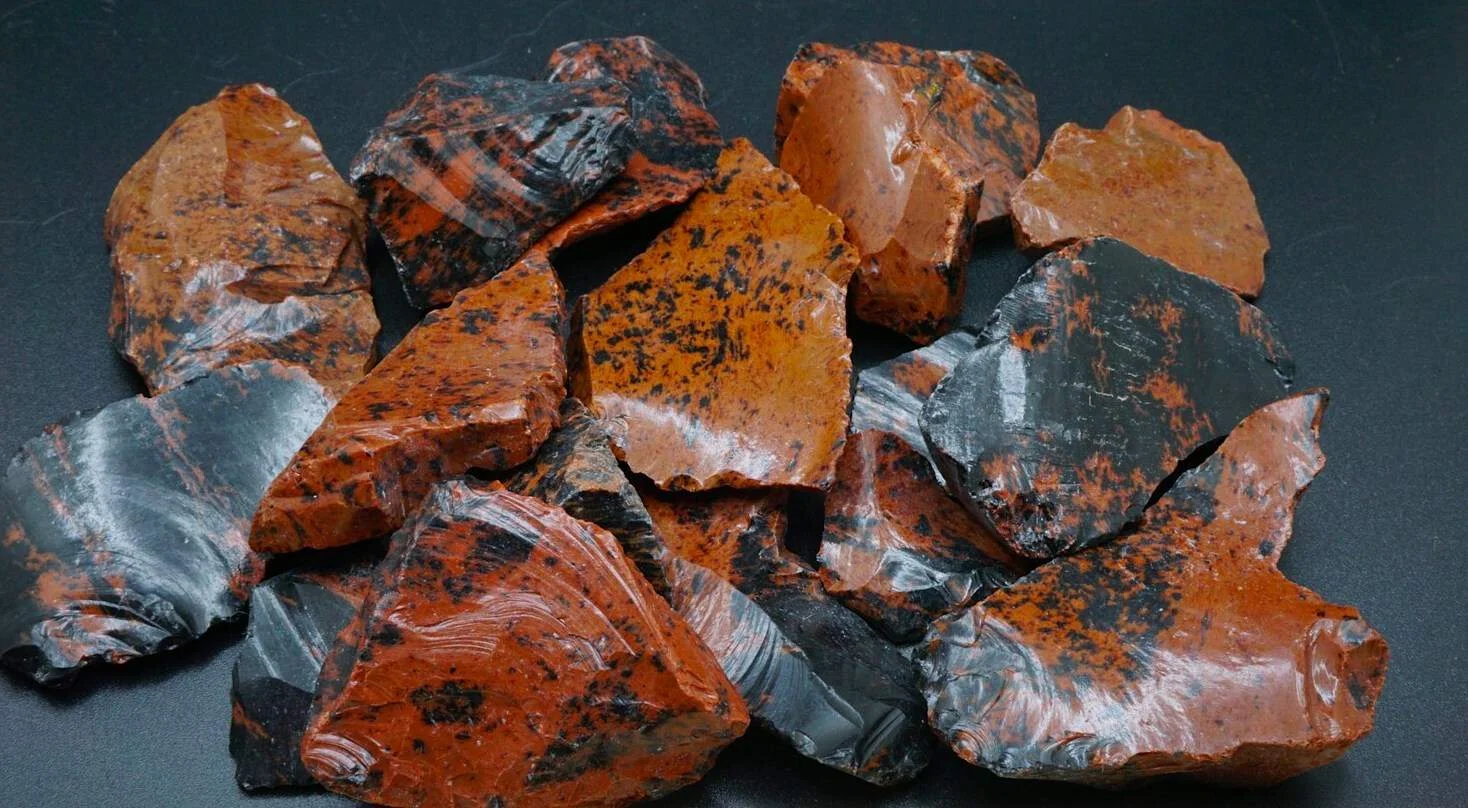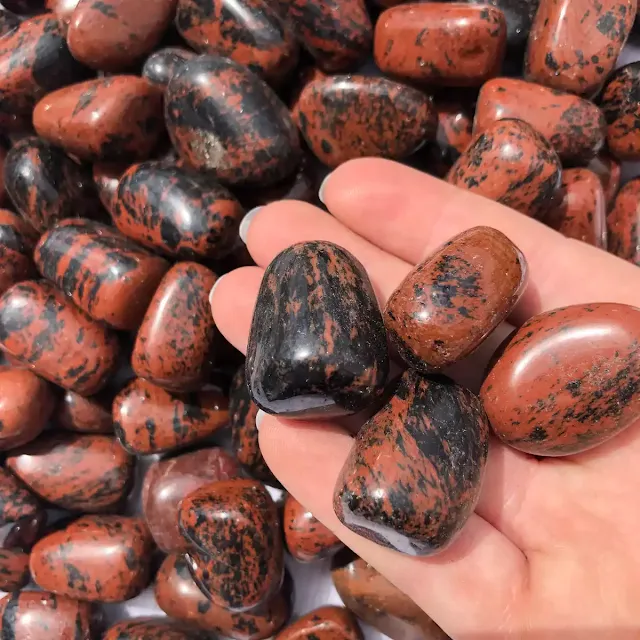Mahogany Obsidian: Red Obsidian
Mahogany Obsidian is a striking variety of obsidian, a naturally occurring volcanic glass formed from rapidly cooling lava. It is characterized by its rich, reddish-brown to deep mahogany-colored patterns set against a dark black or deep brown base. This unique coloration is due to the presence of iron oxide or hematite inclusions within the glass.
Mahogany obsidian is a natural glass, not a true mineral. It forms through the rapid cooling of lava, preventing crystal formation and resulting in its glassy texture.
The name "mahogany obsidian" is descriptive of its color resemblance to the rich, reddish-brown color wood, reminiscent of the wood of the mahogany tree. It can also be called "mountain mahogany" or "Red obsidian."
How is Mahogany Obsidian Formed
Mahogany obsidian is a naturally occurring volcanic glass formed from rapidly cooled lava. This rapid cooling prevents the formation of crystals, resulting in a smooth, glassy texture.
 |
| Rough Mahogany Obsidian |
Extrusive Eruption: Molten rock, rich in silica (SiO₂) and iron oxides (Fe₂O₃), erupts from the Earth's mantle onto the surface as lava. This lava typically exceeds 1200°C (2192°F).
Rapid Cooling: Upon contact with air or water, the lava undergoes explosive cooling. This rapid heat loss, exceeding 100°C per second, prevents the formation of crystalline structures.
Glassy Solidification: The molten rock retains its amorphous state, trapped in a glassy form known as "obsidian." This rapid cooling process hinders the diffusion of ions, preventing the formation of large crystals.
While the base of obsidian is typically black, the presence of mineral impurities can introduce unique colors. In mahogany obsidian, the reddish-brown tones arise from trace amounts of iron and magnesium oxides. These minerals disperse within the glassy matrix, creating the characteristic streaks and swirls that resemble the warm hues of mahogany wood.
Properties of Mahogany Obsidian
Color: Mahogany Obsidian is typically a deep brown to black color with reddish-brown patches or streaks. The color is caused by the presence of iron oxide and other mineral impurities.
Hardness: Mahogany obsidian ranks 5-5.5 on the Mohs scale of mineral hardness, making it relatively durable and scratch-resistant compared to other gemstones.
Fracture: It has a conchoidal fracture, meaning it breaks into smooth, curved surfaces like shells with sharp edges.
Luster: The glassy nature of obsidian gives mahogany obsidian a high, vitreous luster, reflecting light like glass.
Density: It's a relatively dense stone, weighing around 2.3-2.5 g/cm³, contributing to a satisfying heft in the hand.
Magnetic Properties: Due to the presence of iron oxide minerals, some mahogany obsidian varieties exhibit weak magnetic properties.
Transparency: Mahogany Obsidian is opaque, meaning that light cannot pass through it.
Texture: Mahogany Obsidian is smooth and glassy to the touch.
Streak: The streak of Mahogany Obsidian is white to gray. The streak is the color of the mineral powder produced when it is scratched against a streak plate.
 |
| Mahogany obsidian from the Tertiary of Oregon, USA. Photo: James St. John |
Metaphysically
Mahogany Obsidian meaning
Beyond its captivating beauty, Mahogany Obsidian holds rich meaning. It symbolizes transformation and growth, helping us shed limitations and blossom. Its grounding energy offers stability, while its protective spirit shields us from negativity. It can also awaken creativity and passion, sparking self-expression and connection.
Energy: Mahogany obsidian is associated with grounding, protection, and transformation. It's believed to activate the lower three chakras, stimulating growth, sexuality, strength, creativity, and passion.
Properties: It's said to clear negative energy, remove blockages, and promote self-discovery. It's also believed to strengthen the aura and protect against psychic attacks and negative influences.
 |
| Mahogany obsidian. Photo: Captain Tenneal |
Where is Mahogany Obsidian Found
Here are some general locations where Mahogany Obsidian can be found:
Mexico: The volcanic belt boasts coveted mahogany obsidian, renowned for its vibrant colors and intricate patterns. Key locations include Querétaro, San Luis Potosí, and Jalisco.
USA: The Cascade Range in Oregon, Nevada's Black Rock Desert, and Idaho's Obsidian Butte offer stunning deposits with unique color variations.
Japan: Volcanic islands like Hokkaido and Kyushu hold impressive deposits, with Hokkaido's Shiretoko National Park showcasing breathtaking formations.
South America: The Andean Volcanic Belt (Chile to Ecuador) harbors hidden gems. Chile's Atacama Desert and Ecuador's Cotopaxi region offer unique varieties.
Italy: The Lipari Islands, born from volcanic activity, boast a distinctive mahogany obsidian with a near-translucent appearance.
New Zealand: The Taupo Volcanic Zone, particularly the Okataina caldera, is a treasure trove of obsidian, including captivating mahogany varieties.
 |
| This mahogany obsidian outcrop is part of a felsic lava flow that erupted in the Yellowstone Caldera during the last Ice Age (Pleistocene). |
Uses of Mahogany Obsidian
Advanced Medical Tools: Razor-sharp obsidian blades minimize tissue damage in surgeries, while ultra-thin blades enable precise tissue sectioning for microscopic analysis.
High-Precision Instruments: Minimal thermal expansion makes obsidian ideal for spacecraft components and scientific instruments like telescopes.
Archaeology: Obsidian tools and weapons were used by ancient civilizations due to their sharpness and durability. Analysis of Mahogany Obsidian can reveal its origin and provide insights into trade routes and cultural interactions.
Biomedical Potential: Early research suggests biocompatibility for medical implants and potential antimicrobial properties for wound healing.
Gemstone Industry: Mahogany obsidian is valued for its unique beauty and durability, making it a popular choice for jewelry, carvings, and decorative objects.
 |
| Tumbled Mahogany Obsidian |
Cultural Significance:
Mahogany obsidian has been used in various cultures throughout history for its believed properties. For example:
- Mesoamerican cultures: Used for tools, weapons, and ritual objects due to its sharpness and symbolic power.
- Native American cultures: Used for protection, healing, and divination rituals.
- Modern metaphysical practices: Utilized for meditation, personal growth, and energy work.
Red Obsidian
Red obsidian, while intriguing, isn't actually a true obsidian in the scientific sense. The term is often used to describe two different stones:Mahogany obsidian: Described above.
Mahogany obsidian is a specific type of red obsidian, defined by its volcanic glass composition and iron oxide inclusions.
Other Red Stones Misidentified as Obsidian:
Sometimes, other red stones with a glassy appearance can be mistakenly called "Red Obsidian." Examples include red jasper, carnelian, or even chalcedony. These stones have different geological origins and properties compared to true obsidian.
Here's a closer look at some of the most common:
- A microcrystalline quartz variety, not volcanic glass, with iron oxide inclusions creating red coloration.
- Appearance: Jasper comes in various colors, including a vibrant red reminiscent of cherry tomatoes. It has a more opaque and earthy look compared to Obsidian's glassy shine.
- Properties: Jasper is a microcrystalline quartz, making it harder and more durable than Obsidian. It has a rougher texture and lacks the conchoidal fracture of Obsidian.
 |
| This is red jasper Misidentified as Red obsidian |
Carnelian
- Appearance: Carnelian displays a translucent or semi-translucent orange-red to reddish-brown color. It often has a banded or striated pattern and a higher shine than Red Jasper.
- Properties: Carnelian is another microcrystalline quartz, sharing similar hardness and texture to Jasper. It can be polished to a high gloss, often displaying chatoyancy (a cat's eye effect).
Red Chalcedony
- Appearance: Chalcedony encompasses various red varieties, like carnelian and sardonyx. These stones exhibit a waxy luster and can be translucent or opaque.
- Properties: Chalcedony is a cryptocrystalline quartz, meaning it consists of microscopic quartz crystals. It's generally harder than Obsidian but lacks its glassy texture.
Conclusion
Overall, Mahogany Obsidian is a unique and visually striking variety of obsidian prized for its rich reddish-brown coloration and believed metaphysical properties. Whether used for jewelry or spiritual purposes, it continues to be sought after by collectors and enthusiasts alike.
Read also:
What is Green Obsidian?
Snowflake Obsidian
Velvet Obsidian: Volcanic, Shimmering Delight


%20(1).webp)






